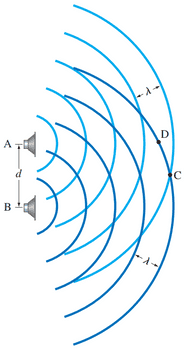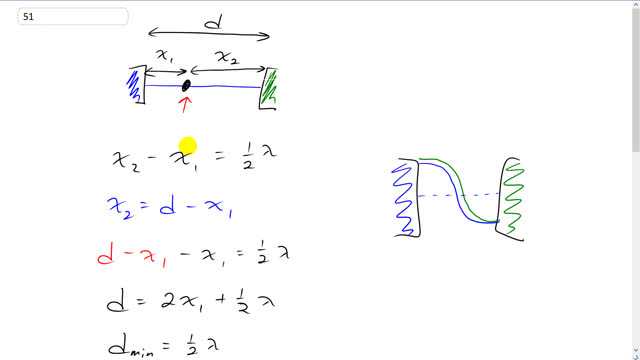
The two sources of sound in Fig. 12–16 face each other and emit sounds of equal amplitude and equal frequency (305 Hz) but out of phase. For what minimum separation of the two speakers will there be some point at which
- complete constructive interference occurs and
- complete destructive interference occurs. (Assume .)


In order to watch this solution you need to have a subscription.
This is Giancoli Answers with Mr. Dychko. These 2 speakers are some distance d apart And this point of constructive interference is a distance x1 from the left hand speaker in a distance x2 from the right hand speaker. And this path length difference between them, x2 minus x1, has to be 1/2 the wavelength. Now, normally this is a formula we wouldn't say for destructive interference but because the speakers are 100 degrees out of phase this is going to now be our constructive interference formula. So, and being 180 degrees out of phase means that at a particular instant in time this is showing the 2 speakers at a particular moment in time when the speaker A is producing a crest, at that same moment in time speaker B is producing a trough. These 2 speakers are 180 degrees out of phase. But the interference is constructive here with this separation between them which we're going to calculate in just a second. So, we know that the x2 is going to be the full separation between them minus x1, d minus x1, so, we make that substitution for x2 and then that makes negative 2 or minus 2 x1 on the left which we can take to the right side to make plus 2 x1 plus this 1/2 λ. And the minimum distance between the speakers will be say, well, that's x1 v0 and in which case we get this picture. And so the minimum separation has to be 1/2 a wavelength this is 1/2 wavelength and if you were to carry it on, it would look like this. And so you see the symmetry here between these 2 sides, the mirror symmetry there. And... And, well, now we have to figure out what this λ is. Now we know that wave speed is frequency times λ. And so divide both sides by f and you get λ is v over f and v is 331 plus 0.6 times temperature divided by f. This is the speed of sound at 20 degrees so, we substitute that in for λ. And so the minimum separation is 1/2 times 331 plus 0.6 times 20 degrees Celsius divided by 305 hertz which is 0.562 meters. Then when we're looking for destructive interference in part b, the path length difference has to be any whole number multiple of the wavelength. And we can choose that to be 0 and that would be the same as putting these speakers right on top of each other. And you can see that the interference would be destructive if they are right in front of each other, because at the moment that the blue speaker is producing a crest, up here, the green speaker would be producing a trough and these will destructively interfere.